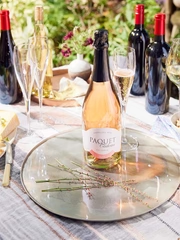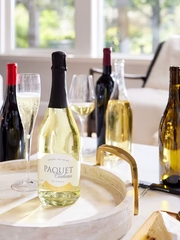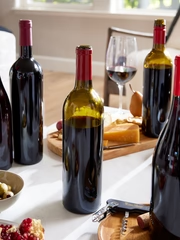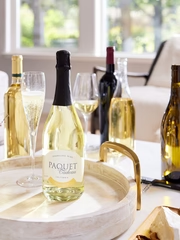 When red grapes are under-ripe, they often have an herbaceous smell and a taste reminiscent of asparagus or bell pepper. Ripe grapes have less of this green, herbaceous character and feature more plum and cherry characteristics.
Grape Analysis: Brix
Sugar constitutes 90% of all the dissolved solids in grape juice. To determine Brix, winemakers measure the weight of the must (pressed juice containing the skins, seeds, and stems of the fruit). A refractometer, seen on the left, uses a refractive index to indirectly measure the must weight from the juice of a single grape.
When red grapes are under-ripe, they often have an herbaceous smell and a taste reminiscent of asparagus or bell pepper. Ripe grapes have less of this green, herbaceous character and feature more plum and cherry characteristics.
Grape Analysis: Brix
Sugar constitutes 90% of all the dissolved solids in grape juice. To determine Brix, winemakers measure the weight of the must (pressed juice containing the skins, seeds, and stems of the fruit). A refractometer, seen on the left, uses a refractive index to indirectly measure the must weight from the juice of a single grape.
 A Hydrometer, seen on the right, is used on a representative sample of berries from a designated vineyard. The same squeezed berry juice will be then used in the lab for different tests.
We multiply the Brix result from the field sample by an alcohol conversion factor of 0.55 to determine the potential amount of alcohol after fermentation.
Example:
2016 Chardonnay, Solano County, picked on 8/24/2016
Brix value was 24.1
Potential alcohol after fermentation will be: 24.1 x .55 = 13.25 % by vol.
Grape Analysis: Acid
The principle acids found in wine grapes are tartaric and malic acids. As sugar levels in grapes rise, the acid levels fall. All wines need some degree of acidity in order to be balanced. For me, this is essential to a good wine.
The titratable acidity or "TA" (also referred to as "total acidity") is the measure of the tartaric acid in the grapes. The TA for regular wines should be between 0.60-0.80%.
Grape Analysis: pH
The pH levels for most wines fall between 3 and 4 on the pH scale. The pH scale measures how acidic/basic something is. The pH level of a wine is the measurement of the amount of free (H+) hydrogen ions. For white wines, winemakers often look for pH readings between 3.1 and 3.4. Red wines can reach up to 4 in cases of an over-ripe Syrah or Zinfandel. At high pH levels, wines become more difficult to handle and they are more susceptible to spoilage.
A Hydrometer, seen on the right, is used on a representative sample of berries from a designated vineyard. The same squeezed berry juice will be then used in the lab for different tests.
We multiply the Brix result from the field sample by an alcohol conversion factor of 0.55 to determine the potential amount of alcohol after fermentation.
Example:
2016 Chardonnay, Solano County, picked on 8/24/2016
Brix value was 24.1
Potential alcohol after fermentation will be: 24.1 x .55 = 13.25 % by vol.
Grape Analysis: Acid
The principle acids found in wine grapes are tartaric and malic acids. As sugar levels in grapes rise, the acid levels fall. All wines need some degree of acidity in order to be balanced. For me, this is essential to a good wine.
The titratable acidity or "TA" (also referred to as "total acidity") is the measure of the tartaric acid in the grapes. The TA for regular wines should be between 0.60-0.80%.
Grape Analysis: pH
The pH levels for most wines fall between 3 and 4 on the pH scale. The pH scale measures how acidic/basic something is. The pH level of a wine is the measurement of the amount of free (H+) hydrogen ions. For white wines, winemakers often look for pH readings between 3.1 and 3.4. Red wines can reach up to 4 in cases of an over-ripe Syrah or Zinfandel. At high pH levels, wines become more difficult to handle and they are more susceptible to spoilage.
 Hang Time
Lately, a new trend has appeared in vineyards. Grapes are being allowed to hang for longer than what has been historically considered a ripe point. This longer hang time produces bigger and bolder wines with higher alcohol levels, which is currently in favor with a growing number of wine critics and winemakers. Some feel this is done at the sacrifice of flavor. This has been an ongoing topic of conversation in the wine industry, one that will continue to be debated well into the future.
Hang Time
Lately, a new trend has appeared in vineyards. Grapes are being allowed to hang for longer than what has been historically considered a ripe point. This longer hang time produces bigger and bolder wines with higher alcohol levels, which is currently in favor with a growing number of wine critics and winemakers. Some feel this is done at the sacrifice of flavor. This has been an ongoing topic of conversation in the wine industry, one that will continue to be debated well into the future.
 Chardonnay, Sauvignon Blanc and Pinot Noir are usually the first grapes of the season to ripen in the Napa Valley. Viognier and Merlot will be the next in line to ripen, then Cabernet Sauvignon, Zinfandel and Petit Verdot last. In summary, there is no single method or indicator that is responsible for a successful harvest season. Acids, pH, sugar and colors are all important components that play an essential role in the finished wine.
Chardonnay, Sauvignon Blanc and Pinot Noir are usually the first grapes of the season to ripen in the Napa Valley. Viognier and Merlot will be the next in line to ripen, then Cabernet Sauvignon, Zinfandel and Petit Verdot last. In summary, there is no single method or indicator that is responsible for a successful harvest season. Acids, pH, sugar and colors are all important components that play an essential role in the finished wine.





